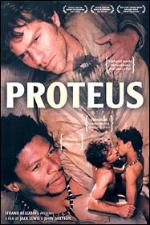

Knight at the Movies ARCHIVES

Old Fashioned Romances, Straight and Gay:
Shall We Dance?, Proteus
10-20-04 Knight at the Movies column
By Richard Knight, Jr.
Anybody who has watched the pleasure that Ellen DeGeneres takes in her daily dance segment on her talk show
will understand the enjoyments of a movie like Shall We Dance?, a remake of the Japanese hit from 1997
(which I have not seen). There is something very freeing about letting oneself be taken away by the music,
regardless of expertise, and it’s the irresistible message of this movie. The picture’s an old fashioned crowd
pleaser, welcome in this fall season heavy with intense though worthy documentaries and stars two icons of the
gay community: Richard Gere and Jennifer Lopez. They have virtually no screen chemistry but look terrific in a
clinch, dancing together. And with profiles like these who needs Fred Astaire and Ginger Rogers?
Gere is certainly getting his money’s worth from those dance lessons he took two years ago for Chicago. He
revitalized his career showing off a determined sprightliness as the singin’, dancin’ Billy Flynn not seen in his other
roles and he does it again in this over the top romantic comedy, his first movie since the smash Oscar winning
musical. Lopez, coming off a series of stinging flops and a long stretch as queen of the tabloids, finally gets to
show off her dancing chops for the first time since Selena in what is essentially a supporting role.
We are once again in a fantasy screen version of our hometown. Gere plays John Clark, a prosperous accountant
who’s obviously at the outset of a midlife crisis. Though he’s got a beautiful, though busy career driven wife,
Beverly (Susan Sarandon) and two perfectly beautiful teenage age children (including the barely glimpsed Stark
Sands who played the gay son in Die Mommie Die), he needs something to renew his spirit. Lucky for John, his
nightly commute on the elevated el takes him through the Loop and stops just long enough for him to glance into
the second story interior of Miss Mitzi’s Dance Studio. One night he spots the beautiful Paulina (Lopez) gazing
longingly out the window, her face bathed in a deep amber light and he is startled out of his mundane reverie by
the intense emotion on her face. On other nights he glimpses her silently sliding around the floor with her
awkward partners and finally he gets off the train to investigate. Before you can say “Gene Kelly” John has signed
up for group dance lessons.
Miss Mitzi (Anita Gillette – where has she been since Moonstruck?) soon has him over his shyness and the weekly
lessons help literally put a bounce back into his step. The seedy but light filled dance studio is jammed with an
assortment of stereotypical comedic characters – much like those in the little seen but kinda enjoyable, kinda icky
Liza Minnelli flop musical from the late 80s, Steppin’ Out. There’s the large sized (and large hearted) Vern (Omar
Miller) who wants to learn to dance for his fiancée, and the homophobic, deeply closeted Italian Stallion, Chic
(Bobby Canavale), who insists that, like his name, he is there to “meet chicks. Toss in tipplin’ Miss Mitzi, owner of
the studio, Paulina’s co-instructor, brash, loud, big wigged Bobbie (Lisa Ann Walter), and Gere’s co-worker, Link
Peterson (Stanley Tucci), the self-described “straight man who likes to dance around in sequins.” Admitting that
he is “walking a very lonely road,” Tucci’s character wears a wig and dark make-up in order to appeal to potential
dance partners and dance contest judges and live out his fantasies.
Of course that doesn’t make sense but then neither does a screen full of modern day characters who don’t have
cell phones (the inclusion of which would pretty much obliterate the plot), or a wife who, instead of asking her
husband, “Where have you been going every week?” hires a lovelorn detective and his verse quoting assistant
(Richard Jenkins and Nick Cannon – both hilarious) to find out.
There is not much that does make practical sense in this deeply clichéd pastiche of at least a dozen other movies.
Yet, it’s well cast with skilled players, has a big, happy ending (never in doubt), lots of amiable to expert, sexy
dancing, and a life-affirming message that made me do a happy dance. You either go The Full Monty with this one
or you stay at home with your two left feet.
+++++++++++++++++++++++++++++++++++++++++++++++++++++++++++++++
Proteus is another old-fashioned movie, albeit one poured through the relatively new mold of the gay cinema
genre. Toward the end of this slow moving, 18th century interracial, forbidden queer love story, a character
comments with a “tsk tsk” about a society with, “Such an appetite for abomination.” Three centuries later, the
appetite for all things queer is stronger than ever – especially by gay audiences wanting to have their long hushed
up stories finally brought to the screen. If many of these narratives easily fit the traditional methods of old
Hollywood, as Proteus does, even better. Hollywood the Dream Factory certainly knew how to produce a good
story and learned early that tragic couples that made audiences weep were the most successful of all.
Proteus, with its doomed lovers casting smoldering looks at each other, heavy reliance on metaphor (vividly
shown through the intermittent flowering and dying “sugar bush” plants), gorgeous cinematography, music and
ingenious costume and set design, certainly fits the bill of a classic, heartbreaking love story. The movie, based on
an actual history of a 1735 sodomy case, involves a black Hottentot and a white Dutch sailor, two prisoners on
Robben Island in South Africa who begin as enemies, then become sex buddies and finally, end up as lovers. This
heavy-lidded male drama, with just the right amount of subplots, would have been clamored for by rival Sapphic
movie queens Greta Garbo and Marlene Dietrich who favored such florid material. Watch it and reward yourself
with a good cry. By the fade out, Proteus, not unlike its ancestors (however distant), Queen Christina, Camille,
and Morocco, earns its tears.
Shall We Dance?, Proteus
10-20-04 Knight at the Movies column
By Richard Knight, Jr.
Anybody who has watched the pleasure that Ellen DeGeneres takes in her daily dance segment on her talk show
will understand the enjoyments of a movie like Shall We Dance?, a remake of the Japanese hit from 1997
(which I have not seen). There is something very freeing about letting oneself be taken away by the music,
regardless of expertise, and it’s the irresistible message of this movie. The picture’s an old fashioned crowd
pleaser, welcome in this fall season heavy with intense though worthy documentaries and stars two icons of the
gay community: Richard Gere and Jennifer Lopez. They have virtually no screen chemistry but look terrific in a
clinch, dancing together. And with profiles like these who needs Fred Astaire and Ginger Rogers?
Gere is certainly getting his money’s worth from those dance lessons he took two years ago for Chicago. He
revitalized his career showing off a determined sprightliness as the singin’, dancin’ Billy Flynn not seen in his other
roles and he does it again in this over the top romantic comedy, his first movie since the smash Oscar winning
musical. Lopez, coming off a series of stinging flops and a long stretch as queen of the tabloids, finally gets to
show off her dancing chops for the first time since Selena in what is essentially a supporting role.
We are once again in a fantasy screen version of our hometown. Gere plays John Clark, a prosperous accountant
who’s obviously at the outset of a midlife crisis. Though he’s got a beautiful, though busy career driven wife,
Beverly (Susan Sarandon) and two perfectly beautiful teenage age children (including the barely glimpsed Stark
Sands who played the gay son in Die Mommie Die), he needs something to renew his spirit. Lucky for John, his
nightly commute on the elevated el takes him through the Loop and stops just long enough for him to glance into
the second story interior of Miss Mitzi’s Dance Studio. One night he spots the beautiful Paulina (Lopez) gazing
longingly out the window, her face bathed in a deep amber light and he is startled out of his mundane reverie by
the intense emotion on her face. On other nights he glimpses her silently sliding around the floor with her
awkward partners and finally he gets off the train to investigate. Before you can say “Gene Kelly” John has signed
up for group dance lessons.
Miss Mitzi (Anita Gillette – where has she been since Moonstruck?) soon has him over his shyness and the weekly
lessons help literally put a bounce back into his step. The seedy but light filled dance studio is jammed with an
assortment of stereotypical comedic characters – much like those in the little seen but kinda enjoyable, kinda icky
Liza Minnelli flop musical from the late 80s, Steppin’ Out. There’s the large sized (and large hearted) Vern (Omar
Miller) who wants to learn to dance for his fiancée, and the homophobic, deeply closeted Italian Stallion, Chic
(Bobby Canavale), who insists that, like his name, he is there to “meet chicks. Toss in tipplin’ Miss Mitzi, owner of
the studio, Paulina’s co-instructor, brash, loud, big wigged Bobbie (Lisa Ann Walter), and Gere’s co-worker, Link
Peterson (Stanley Tucci), the self-described “straight man who likes to dance around in sequins.” Admitting that
he is “walking a very lonely road,” Tucci’s character wears a wig and dark make-up in order to appeal to potential
dance partners and dance contest judges and live out his fantasies.
Of course that doesn’t make sense but then neither does a screen full of modern day characters who don’t have
cell phones (the inclusion of which would pretty much obliterate the plot), or a wife who, instead of asking her
husband, “Where have you been going every week?” hires a lovelorn detective and his verse quoting assistant
(Richard Jenkins and Nick Cannon – both hilarious) to find out.
There is not much that does make practical sense in this deeply clichéd pastiche of at least a dozen other movies.
Yet, it’s well cast with skilled players, has a big, happy ending (never in doubt), lots of amiable to expert, sexy
dancing, and a life-affirming message that made me do a happy dance. You either go The Full Monty with this one
or you stay at home with your two left feet.
+++++++++++++++++++++++++++++++++++++++++++++++++++++++++++++++
Proteus is another old-fashioned movie, albeit one poured through the relatively new mold of the gay cinema
genre. Toward the end of this slow moving, 18th century interracial, forbidden queer love story, a character
comments with a “tsk tsk” about a society with, “Such an appetite for abomination.” Three centuries later, the
appetite for all things queer is stronger than ever – especially by gay audiences wanting to have their long hushed
up stories finally brought to the screen. If many of these narratives easily fit the traditional methods of old
Hollywood, as Proteus does, even better. Hollywood the Dream Factory certainly knew how to produce a good
story and learned early that tragic couples that made audiences weep were the most successful of all.
Proteus, with its doomed lovers casting smoldering looks at each other, heavy reliance on metaphor (vividly
shown through the intermittent flowering and dying “sugar bush” plants), gorgeous cinematography, music and
ingenious costume and set design, certainly fits the bill of a classic, heartbreaking love story. The movie, based on
an actual history of a 1735 sodomy case, involves a black Hottentot and a white Dutch sailor, two prisoners on
Robben Island in South Africa who begin as enemies, then become sex buddies and finally, end up as lovers. This
heavy-lidded male drama, with just the right amount of subplots, would have been clamored for by rival Sapphic
movie queens Greta Garbo and Marlene Dietrich who favored such florid material. Watch it and reward yourself
with a good cry. By the fade out, Proteus, not unlike its ancestors (however distant), Queen Christina, Camille,
and Morocco, earns its tears.
The old formulas updated with satisfying and not so satisfying results

